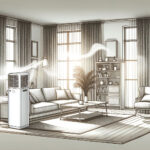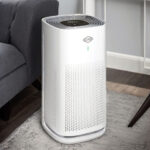Air purifiers are essential for maintaining clean and healthy indoor air. They work by removing pollutants and contaminants from the air, ensuring that you and your family breathe in fresh and purified air. Two important components of air purifiers are the pre-filter and the activated carbon filter. In this article, we will explore the role and importance of these filters in air purifiers.
Key Takeaways
- Pre-filters capture large particles like dust, hair, and pet dander, preventing them from clogging the main filter.
- Pre-filters help extend the lifespan of the main filter, reducing maintenance and replacement costs.
- Activated carbon filters are highly effective in removing odors, gases, and volatile organic compounds (VOCs) from the air.
- Activated carbon filters can neutralize harmful chemicals and toxins, improving indoor air quality.
- Using both a pre-filter and an activated carbon filter in an air purifier provides comprehensive air filtration, ensuring cleaner and healthier air.
The Role of Pre-Filter in Air Purifiers
What is a Pre-Filter?
A pre-filter is an essential component of an air purifier that is designed to capture larger particles and contaminants from the air before it passes through the main filtration system. It acts as the first line of defense, preventing larger particles such as dust, pet hair, and pollen from clogging the main filter. By removing these larger particles, the pre-filter helps to prolong the lifespan of the air purifier and improve its overall efficiency.
- The pre-filter is typically made of a coarse material like foam or mesh, which allows for easy capture of larger particles.
- It is easy to clean and maintain, usually requiring regular vacuuming or rinsing.
- Some air purifiers have replaceable pre-filters, while others have washable pre-filters that can be reused.
Tip: Regularly cleaning or replacing the pre-filter is important to ensure optimal performance of your air purifier.
How Does a Pre-Filter Work?
A pre-filter is an essential component of an air purifier that traps larger particles such as dust, pet dander, and pollen. It acts as the first line of defense, preventing these particles from entering the main filter. The pre-filter works by using a dense mesh or fibrous material to physically capture the particles as the air passes through.
- The pre-filter extends the lifespan of the main filter by capturing larger particles that would otherwise clog it.
- It improves the overall efficiency of the air purifier by reducing the workload on the main filter.
- Regularly cleaning or replacing the pre-filter is necessary to maintain its effectiveness.
Tip: Check the manufacturer’s instructions for guidance on how often the pre-filter should be cleaned or replaced.
Benefits of Using a Pre-Filter
Using a pre-filter in air purifiers offers several benefits. Firstly, a pre-filter helps to capture larger particles such as dust, pet hair, and pollen, preventing them from entering the main filter. This not only prolongs the lifespan of the main filter but also improves the overall efficiency of the air purifier. Secondly, by removing larger particles, a pre-filter helps to reduce the workload of the main filter, allowing it to focus on capturing smaller particles like bacteria and viruses. Lastly, a pre-filter is usually washable or replaceable, making it easy to maintain and cost-effective in the long run.
In summary, the benefits of using a pre-filter in air purifiers include:
- Capturing larger particles
- Prolonging the lifespan of the main filter
- Improving the efficiency of the air purifier
- Reducing the workload of the main filter
- Easy maintenance and cost-effectiveness.
The Importance of Activated Carbon Filter in Air Purifiers
What is an Activated Carbon Filter?
An activated carbon filter is a type of air filter that is designed to remove odors, gases, and volatile organic compounds (VOCs) from the air. It consists of a bed of activated carbon, which is a highly porous material that can adsorb and trap these pollutants.
Activated carbon filters work through a process called adsorption, where the pollutants in the air are attracted to the surface of the carbon particles and stick to them. This helps to improve the air quality by reducing the presence of harmful substances.
Activated carbon filters are commonly used in air purifiers to complement other filtration technologies, such as HEPA filters. They are particularly effective in removing odors from cooking, pets, smoke, and chemicals.
Advantages of Using an Activated Carbon Filter:
- Removes odors and gases from the air
- Reduces the presence of volatile organic compounds (VOCs)
- Complements other filtration technologies
- Effective in removing cooking, pet, smoke, and chemical odors
- Improves overall air quality
How Does an Activated Carbon Filter Work?
Activated carbon filters work through a process called adsorption. This is the process by which molecules from a gas or liquid adhere to the surface of a solid material. In the case of activated carbon filters, the carbon material has a large surface area with many tiny pores that can trap and hold onto various pollutants and contaminants.
Here are some key points to understand how activated carbon filters work:
- The activated carbon material is treated to have a highly porous structure, which increases its surface area and enhances its adsorption capacity.
- When air passes through the filter, the pollutants and contaminants in the air come into contact with the activated carbon surface.
- The pollutants and contaminants adhere to the carbon surface, effectively removing them from the air.
- Activated carbon filters are particularly effective at removing odors, gases, and volatile organic compounds (VOCs) from the air.
Note: It is important to regularly replace the activated carbon filter in air purifiers to maintain its effectiveness.
Advantages of Using an Activated Carbon Filter
Activated carbon filters offer several advantages in air purifiers:
- Effective Odor Removal: Activated carbon has a high adsorption capacity, which allows it to effectively trap and remove odors from the air.
- Chemical Filtration: Activated carbon filters can effectively remove harmful chemicals and volatile organic compounds (VOCs) from the air, improving indoor air quality.
- Gas Filtration: Activated carbon filters are highly effective in trapping and removing various gases, including formaldehyde, benzene, and ammonia.
- Extended Filter Life: The presence of an activated carbon filter in an air purifier can help extend the life of other filters, such as HEPA filters, by trapping larger particles and reducing their load.
Using an activated carbon filter in an air purifier can significantly enhance its overall performance and provide cleaner and fresher indoor air.
Conclusion
In conclusion, both the pre-filter and the activated carbon filter play crucial roles in air purifiers. The pre-filter acts as the first line of defense, capturing large particles and extending the lifespan of the main filter. On the other hand, the activated carbon filter effectively removes odors, chemicals, and volatile organic compounds from the air, improving indoor air quality. By using both filters, air purifiers can provide cleaner and healthier air for individuals. Therefore, it is important to understand the importance of these filters and consider them when purchasing an air purifier.
Frequently Asked Questions
1. What is the purpose of a pre-filter in an air purifier?
A pre-filter in an air purifier is designed to capture larger particles such as dust, pet hair, and pollen. It helps to extend the lifespan of the main filter by preventing these particles from clogging it.
2. How often should I replace the pre-filter in my air purifier?
The frequency of pre-filter replacement depends on usage and the level of pollutants in your environment. It is generally recommended to replace the pre-filter every 3 to 6 months for optimal performance.
3. Can I clean and reuse the pre-filter?
Most pre-filters are not designed to be cleaned and reused. It is recommended to replace the pre-filter with a new one when it becomes dirty or clogged.
4. What is the role of an activated carbon filter in an air purifier?
An activated carbon filter in an air purifier is used to remove odors, gases, and volatile organic compounds (VOCs) from the air. It has a porous structure that traps and absorbs these pollutants, improving the overall air quality.
5. How long does an activated carbon filter last?
The lifespan of an activated carbon filter depends on various factors such as the level of pollutants in the air and the size of the filter. On average, an activated carbon filter can last between 6 to 12 months.
6. Can an activated carbon filter remove all types of odors?
While activated carbon filters are effective at removing many common household odors, they may not be able to eliminate strong or persistent odors. For specific odors, it is recommended to choose an air purifier with additional specialized filters.







